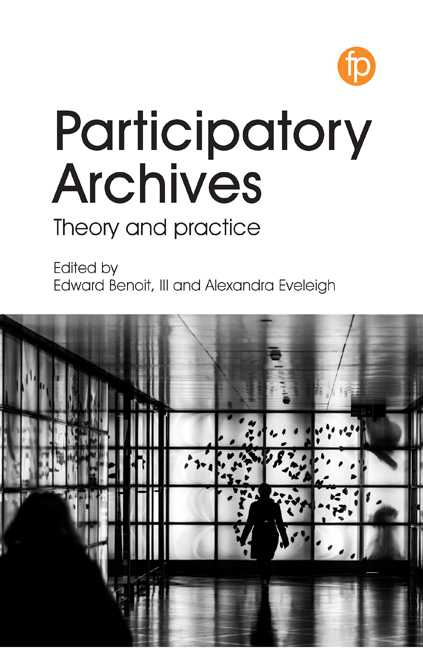Book contents
- Frontmatter
- Contents
- Figures and table
- Notes on contributors
- 1 Defining and framing participatory archives in archival science
- SECTION 1 SOCIAL TAGGING AND COMMENTING
- SECTION 2 TRANSCRIPTION
- 6 Engaging curation: a look at the literature on participatory archival transcription
- 7 Subtle transformations: increasing participation and access through transcription
- 8 Crowdsourcing metadata for time-based media in the American Archive of Public Broadcasting
- 9 Participatory transcription in Amsterdam and Copenhagen
- SECTION 3 CROWDFUNDING AND OUTREACH
- SECTION 4 ALTERNATIVE AND ACTIVIST COMMUNITIES
- Notes
- Index
6 - Engaging curation: a look at the literature on participatory archival transcription
from SECTION 2 - TRANSCRIPTION
Published online by Cambridge University Press: 25 October 2019
- Frontmatter
- Contents
- Figures and table
- Notes on contributors
- 1 Defining and framing participatory archives in archival science
- SECTION 1 SOCIAL TAGGING AND COMMENTING
- SECTION 2 TRANSCRIPTION
- 6 Engaging curation: a look at the literature on participatory archival transcription
- 7 Subtle transformations: increasing participation and access through transcription
- 8 Crowdsourcing metadata for time-based media in the American Archive of Public Broadcasting
- 9 Participatory transcription in Amsterdam and Copenhagen
- SECTION 3 CROWDFUNDING AND OUTREACH
- SECTION 4 ALTERNATIVE AND ACTIVIST COMMUNITIES
- Notes
- Index
Summary
This chapter discusses some of the prominent themes in the literature on participatory transcription and archives. After an introduction, it investigates the relationship of participatory transcription with crowdsourcing and how it is used in different kinds of archives. There is then an analysis of the kinds of transcription used in archives, looking at where participatory transcription fits into the institutional priorities of archives, their outreach and backlog processing. Finally, it considers challenges inherent to transcription projects and those brought about by archives’ use of participatory transcription.
Locating participatory transcription
Transcription figures prominently within the field of participatory archives. During transcription projects, content is transformed ‘from one format to another’ whether by transcription, tagging, synthesis or the production of new materials by volunteer ‘participants’. Parilla and Ferriter explain, ‘As collection items have been digitized, more questions about discovery and research “within” these items have emerged. One solution to increase and improve the data associated with digitized collections is to crowdsource transcription.’
Participatory transcription is about sharing control of archival content curation ‘with users who self-identify as stakeholders in the archives’ content’. When there is participatory transcription, the suggestions and work of archival users contribute substantially to content development. Taking this into account, Theimer's definition of participatory archives acknowledges the descriptive work usually undertaken by non-archivists in a digital environ - ment in the form of transcribing, tagging and providing metadata.
Archival transcription projects can include audio, handwritten documents and/or printed text; indeed early crowdsourcing research included speech transcription. Additionally, the reCAPTCHA system, ‘a snippet transcription tool’, is another good example of general crowdsourced transcription of audio and textual materials. Overwhelmingly, however, the archival literature focuses on the transcribing of handwritten or early print texts. Participatory transcription fits well within the ‘others as informants’ discourse Huvila found in participatory archives literature, which ‘portrays others [nonarchivists] as informants that can give archivists valuable input for their work in describing and managing records’.
Is the crowd participating?
This chapter assumes that there is overlap or synonymy between the terms ‘participatory transcription’, ‘crowdsourced transcription’, ‘community transcription’ and even ‘human computation’ when applied to transcription. In other places in the literature, participatory transcription is described as public participation, crowd collaboration, popular participation, heritage crowdsourcing, community-contributed transcription and volunteer thinking.
- Type
- Chapter
- Information
- Participatory Archives , pp. 73 - 84Publisher: FacetPrint publication year: 2019

